Many people think of summer when it comes to Japanese festivals, but there are actually so many different festivals happening throughout the year. Of course, especially in summer, you can hear the sound of Japanese drums at festivals and the dashing shouts of people carrying mikoshi (portable shrines) almost every weekend.
Indeed, summer is arguably the best season to go outdoors and stay up late because of the warm temperatures and longer sunshine. Yet, Japan has a lot more festivals to offer in different seasons. Check out these 20 Japanese festivals not to miss out on in Japan in 2024.
What are Japanese Festivals?
The Japanese believe that there is a god in everything, with eight million gods existing all around us. Japanese festivals, known as matsuri locally, are held to thank nature and the gods, celebrate life, and foster community. They also offer an opportunity for Japanese people to let loose.
Participating in festivals lets you have a deeper understanding of Japan. You can experience Japanese history, culture, and customs that you do not usually see in everyday life. It is a great opportunity to interact with local people and see a new side of their unique culture.
Join Japanese festivals and feel the energy of Japan for yourself!
Japanese Festivals in Japan in 2024
1. Beginning of February: Sapporo Snow Festival (Sapporo, Hokkaido)

Date: 4th Feb – 11th Feb, 2024
The Sapporo Snow Festival is the biggest and most famous snow festival in Japan. About 200 snow and ice sculptures line up in Odori Park, the main venue, over a distance of about 1.5 km. At night, the entire venue is lit up with different lighting and projection mapping, creating a fairy tale world.
The Sapporo Snow Festival is held in February every year for about one week. Many people from all over Japan and even the world come to visit Sapporo during the festival. The highlight of the Sapporo Snow Festival is a huge sculpture made of snow and ice. You can enjoy various ice sculptures such as those that imitate world-famous places and those with the theme of movies and manga.
There are also unique ice sculptures such as cup ramen and beer made of snow and ice. If you think you are creative and have a good idea about making ice sculptures, you might be interested in the public recruitment for production teams, conducted every November.
Only pure snow is used in the festival due to safety concerns. It is estimated that the festival requires 30,000 tons of snow.
2. Mid-February: Nagasaki Lantern Festival (Nagasaki, Nagasaki Prefecture)
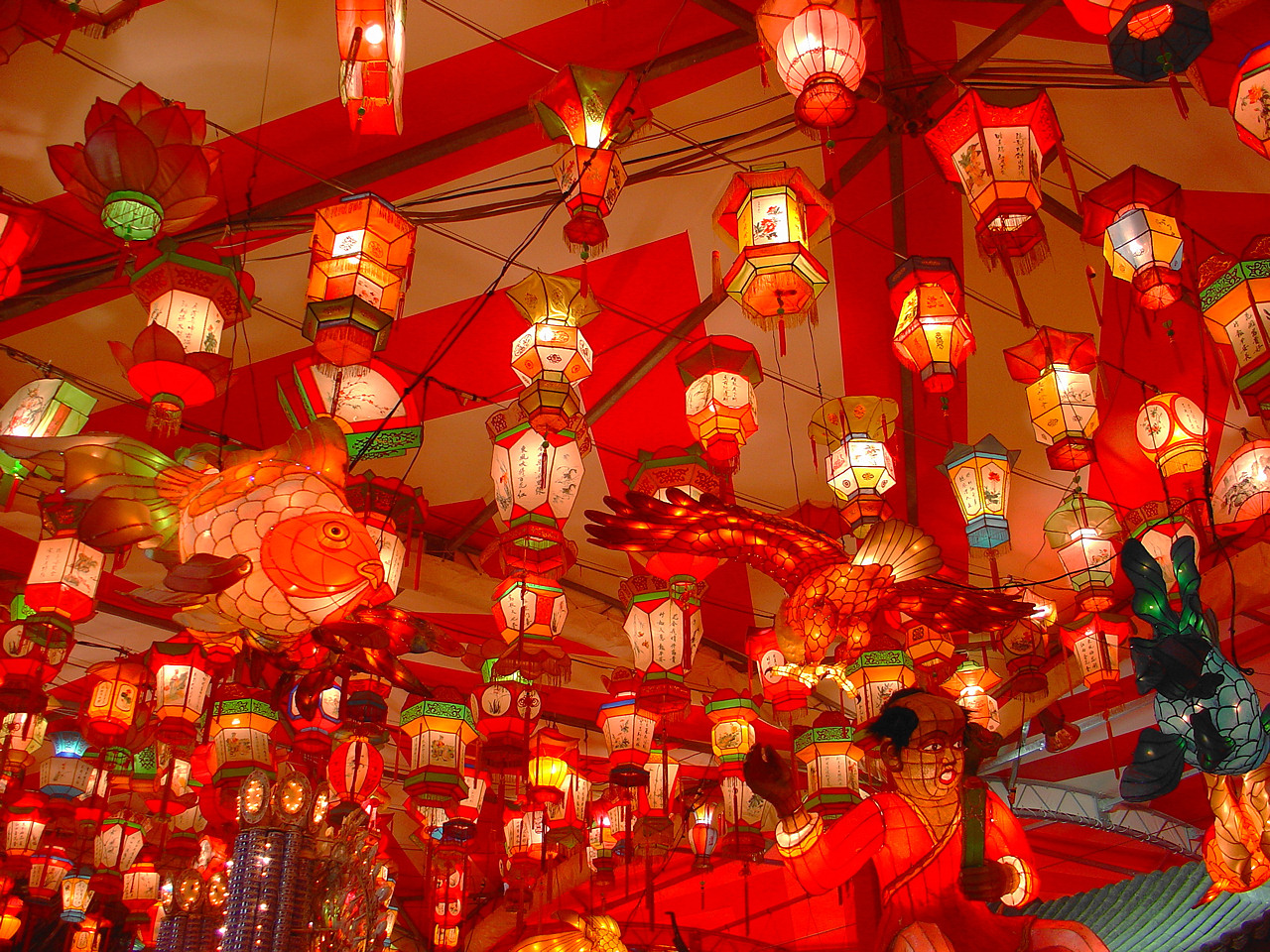
Date: 22nd January – 5th February, 2024
The Nagasaki Lantern Festival is a fantastic and exotic world where the city of Nagasaki in winter is filled with 15,000 colourful lanterns. It started as a festival to celebrate the Chinese New Year in Nagasaki Chinatown and has been held since 1994, creating a fantasy world of lights and festivities.
At the Nagasaki Lantern Festival, you can find large lantern objects that shine brightly, such as dragons, large snakes, kirin, and characters of Nishiyuki and Sangokushi. They are displayed in different parts of the city.
During this period, there are plenty of events where you can fully enjoy the charm of Chinese culture, such as traditional Chinese lion dance, dragon dance, erhu performance, and Chinese acrobatics.
There are also many romantic decors of the festival that are perfect for couples to visit, such as the “Doza River,” where pink lanterns are reflected on the surface of the river, and the “Nagasaki Koi Lantern,” where lantern objects for romance prayers are dedicated at the Confucius Temple venue.
3. Mid-March: Omihachiman Sagicho Fire Festival (Omihachiman City, Shiga Prefecture)
Date: March 12th-13th
The Sagicho Festival takes place on the third weekend of March every year. The peak of the festival is on Sunday evening. This festival is said to have been performed by Nobunaga Oda under Azuchi Castle.
The portable shrine called Sagicho is decorated after the zodiac of the year, and you will see lots of creativity from the locals by using food ingredients to form the shape of the animal of the year. More than a dozen portable shrines parade through each town.
Once the winner of the Sagicho is decided, all of the Sagicho are ceremoniously burned. While the floats go up in smoke, men dance wildly in close proximity to the flames and pray for the peace of the year with the burning flames.
4. Beginning of April: Kanamara Festival (Kawasaki)
Date: First Sunday of April
The Kanamara Festival is held in Kawasaki City every April. A portable shrine in the shape of a penis is paraded around, making this a widely known festival worldwide. The Kanamara Festival is held at Kanayama Shrine, which is known for its prosperous business, childbirth, and harmonious marriage.
At Kanamara Festival, not only do you get a chance to enjoy the huge penis on the portable shrine, but you can also savour the delicacies of sweets and souvenirs in the shape of penises.
Kanamara Festival has meaning for many people. It is popular for people to wish for a world where there is no discrimination in childbirth and any gender identity.
This festival was born from the idea that “a festival that everyone can enjoy in the daytime, regardless of their status or sexual orientation, even if they are ill.” For this reason, it also has great significance for the Japanese LGBTQ community.
One of the three male genital portable shrines that appear in the Kanamara Festival was donated by a cross-dressing club called “Elizabeth Kaikan.”
If you visit Tokyo or Kawasaki in early April and hope for a better and more equal world, why not join this festival to celebrate equality and vitality?
5. Mid-April: Takayama Spring Festival (Takayama City, Gifu Prefecture)

Date: 14th-15th April, 2024
Takayama Festival is a general term for “Sanno Festival” in spring and “Yawata Festival” in autumn. The spring and fall festivals feature quite similar events, as the main attraction is displaying festival floats.
The festival can be traced back to the Edo period. The Sanno Festival, which announces the arrival of spring in Takayama, is an annual festival of Hie Shrine, the god of the southern half of the former Takayama castle town, and has a history of more than 300 years.
You can find 12 gorgeous food stalls parading through the cherry blossoms here. At the night festival, all the stalls also light up about 100 lanterns, bringing to you a different scenery.
6. Beginning of May: Hakata Dontaku (Fukuoka, Fukuoka Prefecture)
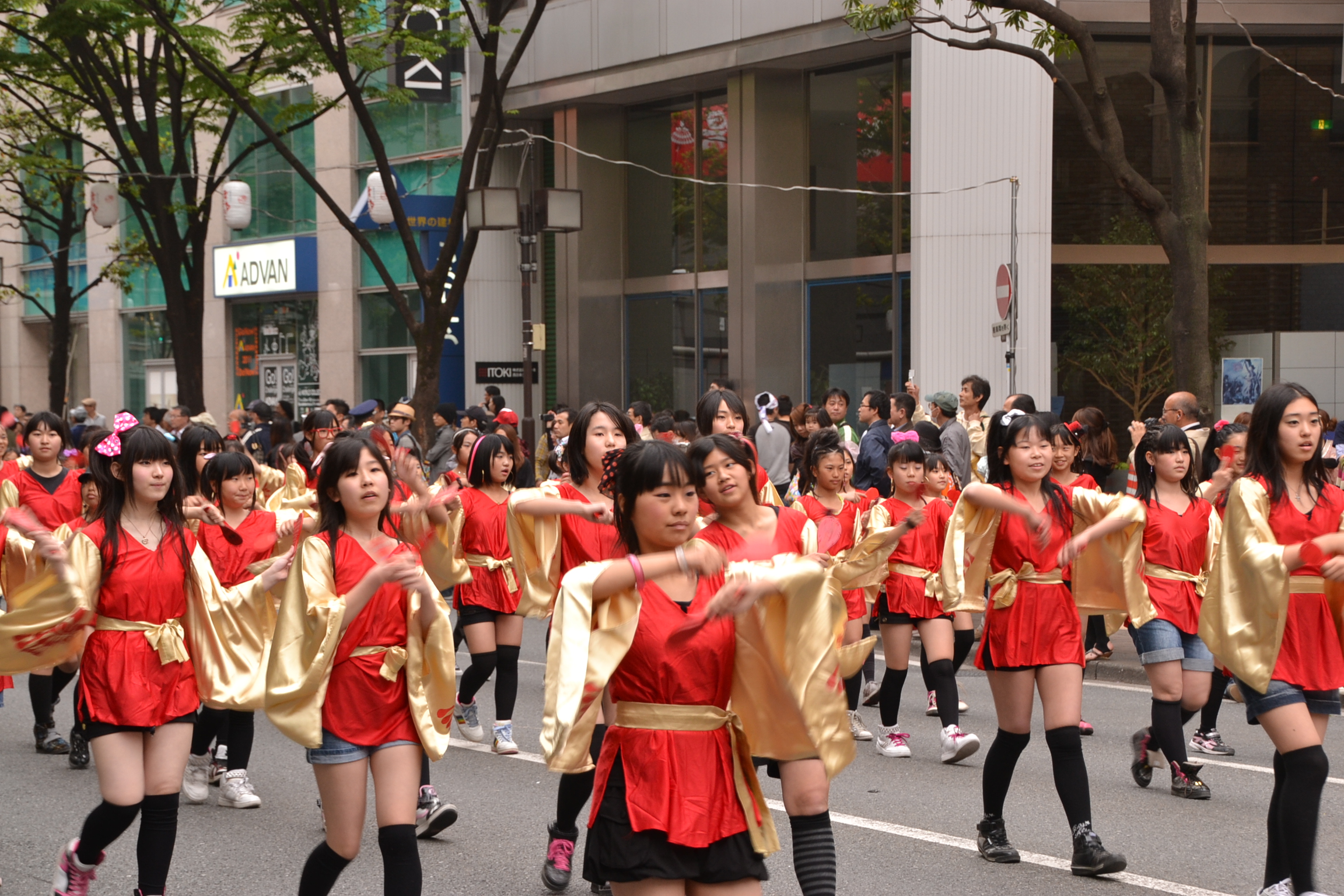
Date: 3rd-4th May, 2024
Hakata Dontaku is a festival attended by more than 2 million people from Japan and overseas. The word “Dontaku” comes from the Dutch word “zondag,” which means Sunday or holiday.
Men and women of all ages dress up as they parade through the town and perform dances on stages throughout the town. It is a festival that both locals and tourists get to enjoy.
A lot of people say that while attending the Hakata Dontaku, they discover lots of amazing local foods in Hakata. If you get the chance to participate in the event, make sure to try Hakata Ramen and Karashi Mentaiko!
7. Mid-May: Sanja Matsuri (Asakusa, Tokyo)

Date: To be announced (21st-22nd May, 2024)
Sanja Matsuri is held at Asakusa Shrine in Asakusa. According to ancient documentation, the festival has been held since 1312 and has a history of 700 years.
The festival is held from Friday to Sunday, the third week of May every year and lasts for three days. It is one of the largest festivals in Tokyo and is visited by about 150,000 people.
For those who want to see a portable shrine, the festival offers some of the best. In addition to the three portable shrines of Asakusa Shrine, which can be said to be the protagonist of the festival, as many as 100 portable shrines will be released from the surrounding towns.
There are also small and light portable shrines that can only be carried by children and women. Recently, it has become more common to see women carrying portable shrines, but it is unique to see portable shrines carried only by women.
Sanja Matsuri is recommended for people who like historical festivals and portable shrines. It is a must-see as it is held in the Asakusa area, which is a typical sightseeing spot in Tokyo.
8. Beginning of June: Sanno Festival (Chiyoda-ku, Tokyo)

Date: To be announced (4th June – 13th June, 2024)
The Sanno Festival is considered one of the three major festivals in Edo and has a history of more than 500 years. During the Edo period, it was a festival that was allowed to enter Edo Castle and was worshipped by the shogun.
The festival stage is set up in the centre of Tokyo, in places like the Imperial Palace and Marunouchi. The festival displays different mikoshi and floats with phoenix decorations. Come and feel like you have travelled back to the Edo period.
The Sanno Festival is only held on even-numbered years. The festivities last for 11 days.
You will see a nine-hour long parade beginning and ending at the Hie-jinja Shrine and multiple costume performances. The festival is a great experience for those who are interested in traditional Japanese culture, as many ancient Japanese arts, folk dances, rituals, and ceremonies will be performed as part of the festivities.
It’s hard to choose which day is the best to visit the festival because the festival features a wide range of events and activities every day. If you have the time, don’t hesitate to join the celebration for more than one day, because this is one of the best kinds of cultural immersion!
9. The month of July: Gion Festival (Kyoto City, Kyoto Prefecture)

Date: To be announced (1st July – 31st July, 2024)
The Gion Festival in Kyoto is one of the three major festivals in Japan. The festival takes a month from the beginning of July and attracts many people from all over the world. During Gion Matsuri, 33 floats called Yamaboko are showcased with the theme of Japanese legends. All are prepared over long periods of time for this festival.
The biggest highlight is the Yamahoko parade, which is held at the pre-festival and the post-festival. The Gion Hayashi and the floats are so gorgeous that they are called “moving museums.”
Many people come during the day to see the festival, but it’s recommended to visit after dark. When the countless lanterns on the floats are lit, the atmosphere of the festival changes completely. It is a fantastic sight like a sea of light, which is both mysterious and beautiful.
This lively festival goes well with the atmosphere of the historic Gion town. If you visit during the festival, you will feel as if you have travelled back in time.
When travelling to Japan in the summer, be sure to visit Kyoto’s famous Gion Matsuri.
10. First half of July: Fukuoka Hakata Gion Yamakasa (Fukuoka)

Date: 1st July – 15th July, 2024
The Hakata Gion Yamakasa Festival is a festival that represents Fukuoka and Hakata and has been held for over 700 years at Kushida Shrine, also known as the guardian of Hakata.
The Hakata Gion Yamakasa was registered as a UNESCO World Cultural Heritage Site. About 800 years ago, in Hakata, where an epidemic was prevalent, it is said that the festival originated when a monk rode a wooden trolley carried by the residents and sprinkled water throughout the town to pray for the epidemic to disappear.
The Hakata Gion Yamakasa features a portable shrine, called Yamakasa, being carried while running at full speed in town. Every year from July 1st to 15th, the city of Hakata comes to life. Yamakasa is very heavy, and even a strong man can only pull it for a few minutes. Besides the main Yamakasa shrine, ornamental Yamakasa that are around 10 to 15 metres high appear in different parts of the city.
Don’t confuse Fukuoka’s Hakata Gion Yamakasa with Kyoto’s Gion Festival, which also takes place in July.
11. Tenjin Matsuri (Osaka)

Date: To be announced (24th July – 25th July, 2024)
The most unique feature of the Tenjin Matsuri is the Yarimawashi, which is a 4-ton danjiri float that turns vigorously while being pulled around corners at full speed. This brave, breathtaking, and beautiful scene is the result of the unity of each town.
Yarimawashi is made up of many different elements. Daikugata dances on the roof of the running danjiri, the people at the front of the danjiri require unique skills to guide the danjiri, and the people in the back are in charge of steering. Each member wears a twisted headband, a belly band, breastplate, a patch, and a happi coat that represent each town.
Not only is the excitement of the festival significant, but also the sculptures of famous scenes from war memorials and mythological stories carved in the zelkova-made danjiri are truly beautiful.
12. Beginning of August: Aomori Nebuta Festival (Aomori City, Aomori Prefecture)
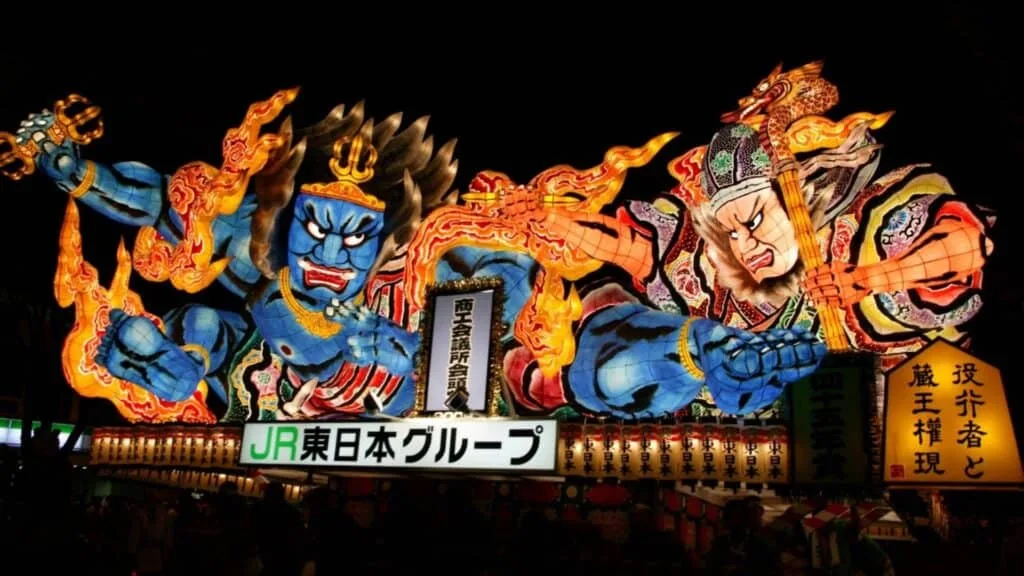
Date: To be announced (1st August – 7th August, 2024)
The Aomori Nebuta Festival is one of the representative summer festivals in Tohoku, a region in Northern Japan. The origin of “Nebuta” is said to have derived from the Tanabata lanterns. The doll lanterns, which are created based on different mythologies, are about 5 metres high and 9 metres wide.
In the middle of the Edo period, people started to dance with lanterns and floats. In the late Edo period, lantern floats that we see nowadays started to appear in the festival.
The Aomori Nebuta Festival is held for six days. No float is displayed on the eve of the festival. On the following day, a total of 30 nebutas are displayed. Then, locals carry these floats in a parade and they are displayed for viewing in the evening.
You will get the opportunity to see floats in the daytime on the last day of the festival. Once the festival is over, most floats will be disassembled while some will be displayed in the Nebuta Museum.
13. Mid-August: Kyoto Gozan no Okuribi (Kyoto)
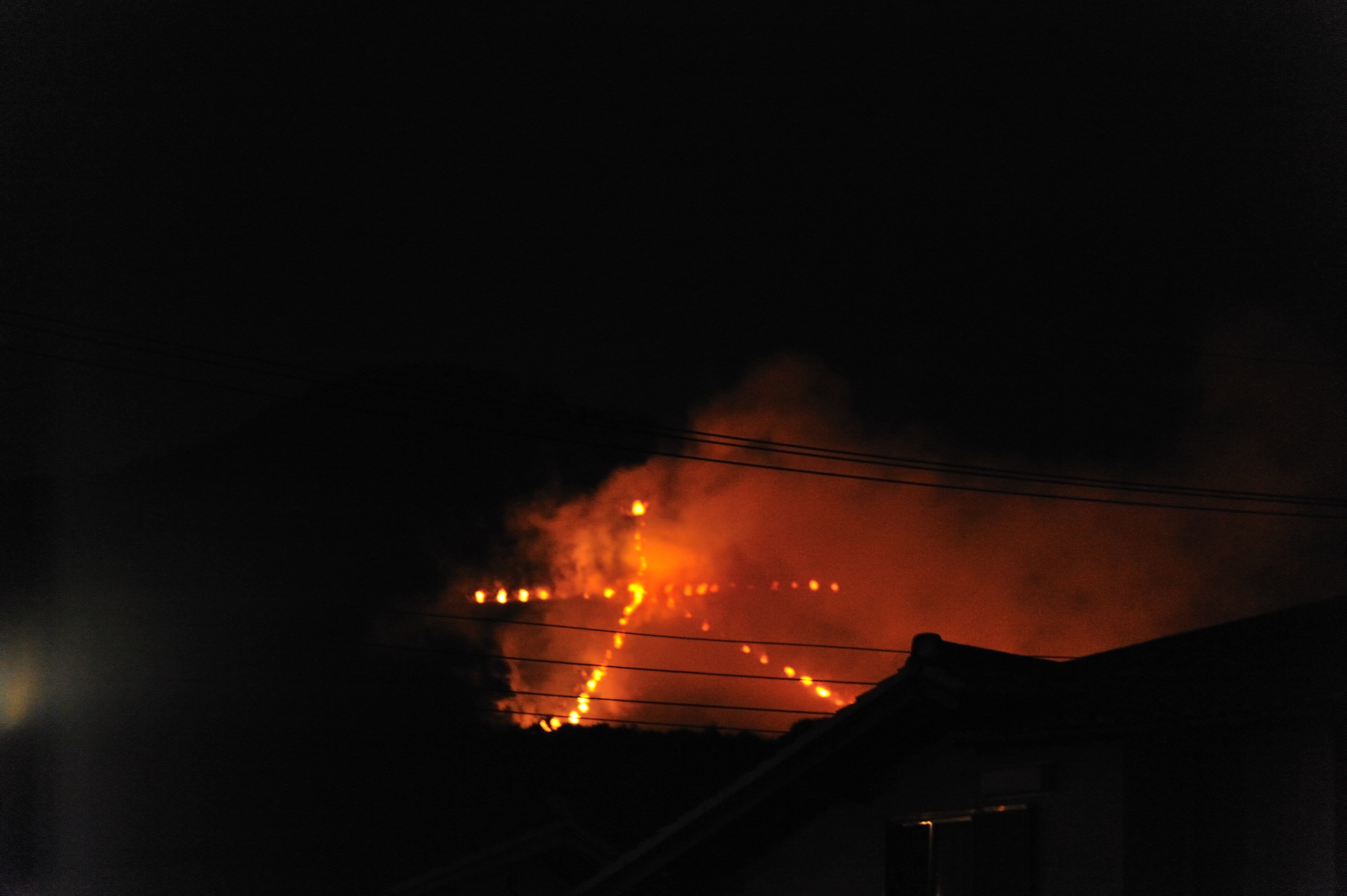
Date: To be announced (16th August, 2024)
Every year on the night of August 16th, the magnificent flame letters emerge one after another in the mountains of Kyoto.
The traditional Buddhist event “Kyoto Gozan no Okuribi” is one of the four major events in Kyoto. Five okuribi are lit in sequence, each burning for about 30 minutes.
Starting at 8 PM, the giant bonfires are lit, each with a distinctive shape. Three of the fires form giant kanji characters and two form shapes.
Daimonji (大文字), the character meaning “large”, is lit on Daimonji-Yama at 8:00 PM.
Myō/Hō (妙・法), the characters referring to Buddhist teachings “wondrous dharma”, on Matsugasaki at 8:10 PM.
Funagata (舟形), the shape of a boat, on Nishigamo at 8:15 PM.
Hidari Daimonji (左大文字), the character meaning “large”, on Daihoku-San at 8:15 PM.
Toriigata (鳥居形), the shape of a torii gate, on Toriimoto, Mandara-San at 8:20 PM.
During the ceremonies, people send the spirits of their ancestors and pray for the health of the living. There are best spots in Kyoto to see each bonfire, but if you want to see all five, the hotel rooftops and guest rooms around Kyoto Station are the best.
14. End of August: Koenji Awa Odori (Tokyo)

Date: To be announced
Tokyo Koenji Awa Odori is a summer tradition in Tokyo where 10,000 dancers and 1 million spectators gather. Awa Odori is a traditional local entertainment that originated in Tokushima Prefecture and has continued for 400 years.
The dancers wear happi coats and dance energetically down the streets of Koenji during this festival. The Tokyo Koenji Awa Odori is the largest Awa Odori tournament in eastern Japan, with more than 60 years of history. Local Koenji groups and more than a hundred unique groups come and join from all over the country.
The tournament is held for two days and the shopping streets and streets around Koenji Station are surrounded by the enthusiasm and cheers of Awa Odori.
15. Mid-August: Awa Odori (Tokushima)

Date: To be announced (12th August – 15th August, 2024)
Awa Odori is a term that refers to both the local dance of Tokushima and one of the largest festivals in Japan. The festival is held during the Obon festival when the souls of the dead are thought to return to their hometowns. It is believed that Awa Odori welcomes the souls of the dead.
The origin of Awa Odori dates back to Tokushima 400 years ago. The word “awa” is the old name for Tokushima, and “odori” means dance.
During the festival, dancers in brightly coloured costumes perform unique and energetic dances. The joyful music of the festival and the costumes of the dancers are some of the many highlights.
The song of the festival is another big attraction. It is very popularised in Japan because it is very catchy. The lyrics of Awa Odori are:
The dancers are fools
The watchers are fools
Both are fools alike so
Why not dance?
Anyone can participate in the dance, and there is also a stage where the audience can join in.
16. End of August: Okinawa Island-wide Eisa Festival (Okinawa)

Date: To be announced, Late August 2024
The Okinawa Zento Eisa Matsuri is a festival held annually during the Obon festival. This is a major event that takes place over three days in Okinawa City in the central part of the main island.
“Eisa” is a traditional Okinawan performing art that takes place during the Obon festival. A signature flag is raised 3 to 4 metres high with shamisen performances and different dance performances.
On the first day of the festival, visitors visit Michijune, a parade in the city. On the other days, at Koza Sports Park in Okinawa City, you will get to enjoy Eisa performed by youth groups of Okinawa and other prefectures. There is also a laser show and fireworks launch at the end of the festival.
17. Beginning of October: Nihonmatsu Lantern Festival (Nihonmatsu City, Fukushima Prefecture)

Date: To be announced (4th October – 6th October, 2024)
The Nihonmatsu Lantern Festival is one of Japan’s three lantern festivals. The annual festival of Nihonmatsu Shrine has a history of about 350 years. A huge drum stand, called taikodai, at 11 metres or more is set up, along with more than 3000 lanterns being paraded through the town. The red lanterns lit on the seven drums from each town are illuminated.
Lighting up lanterns is not an easy job because fires burn out quickly. Each float needs around 150 candles per night!
18. Sawara Grand Festival (Katori, Chiba)
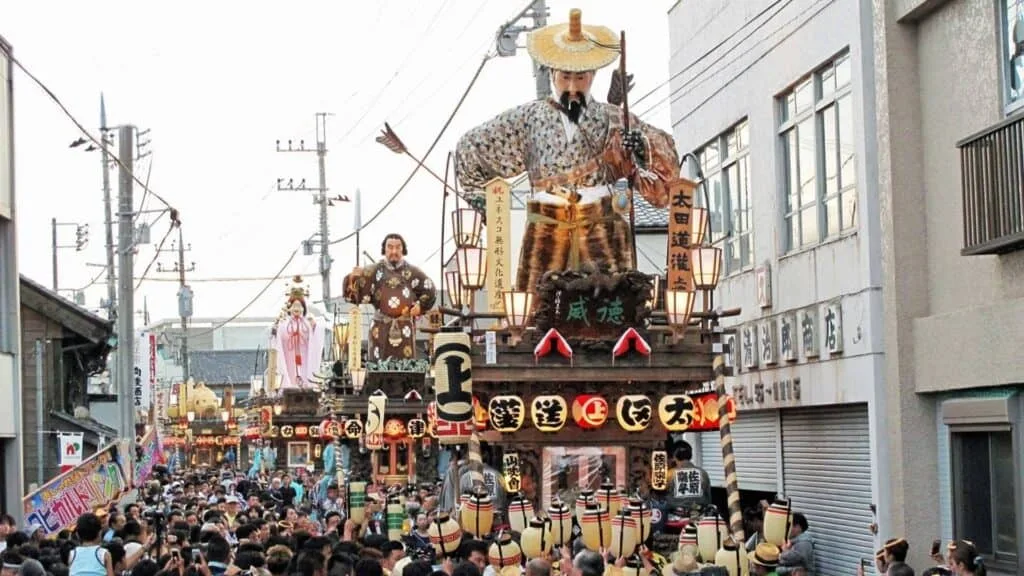
Date: To be announced (8th October – 10th October, 2024)
Sawara no Taizai is a festival held in Katori City, Chiba Prefecture, for three days in the second week of October. The floats that are put out at the festival are prepared by local residents with great care over the year. The Sawara no Taizai floats are considered to be one of the largest floats in Japan.
In the centre of each float, there is a doll, which is the centrepiece. The dolls are famous historical figures and mythical characters of Japan. Participating in the festival not only allows you to enjoy floats and dances but also helps you to quickly become familiarised with the history of Japan.
19. November: Tori no Ichi (Yokohama)

Date: To be announced (Early – Late November 2024)
The Kotohira Otori Shrine is loved by locals. Tori no Ichi takes place here as an annual event that announces the early winter of Yokohama. Hundreds of craftsman-made lanterns dedicated by local residents and companies are displayed and hundreds of stalls line up along the surrounding streets.
The stalls sell Kumade, “lucky rakes,” that sweep the fortune to you. Small rakes cost thousands to hundreds of thousands of yen, and large ones can cost up to millions of yen. Pray for good luck and prosperity with these rakes and if you are buying for the first time, start with the smaller ones.
You can also enjoy the festive mood by playing with goldfish scooping and shooting and enjoying the classic apple candy and takoyaki.
20. Beginning of December: Chichibu Night Festival (Chichibu City, Saitama Prefecture)

Date: To be announced (2nd December – 3rd December, 2024)
The annual festival of Chichibu Shrine has been a grand event since the middle of the Edo period. It is one of the biggest festivals in the Kanto area. It is held annually on the second and third of December.
On the day of the event, six brightly lit and decorated floats are towed through the city in early winter. During the towing, Japanese dance is performed on the stalls, and plays are performed.
The other big attraction of the festival is the fireworks, as it is one of the few times you can see fireworks in wintertime. Fireworks will be displayed for 2.5 hours, giving you the full opportunity to enjoy the gorgeous view. The festival area isn’t very big, so you can also choose to see the fireworks from rooftops in the area.
Experience the Rich Culture and Traditions of Japan
Attending Japanese festivals is a unique and immersive way to experience the rich culture and traditions of Japan. Each festival, from the vibrant Sapporo Snow Festival in February to the enchanting Chichibu Night Festival in December, offers a distinct glimpse into the local customs, historical significance, and communal spirit that define these celebrations. By participating in these festivals, you not only witness the incredible artistry and dedication that go into the elaborate floats, lanterns, and performances but also engage with the warm and welcoming communities that host these events. This personal interaction and firsthand experience provide an unparalleled understanding of Japan’s multifaceted cultural heritage.
As you plan your travels to Japan in 2024, make sure to include these unforgettable festivals in your itinerary. Whether you’re marvelling at the intricate ice sculptures in Sapporo, joining the energetic dances of the Awa Odori, or admiring the beautiful lanterns in Nihonmatsu, each festival promises a memorable adventure that will leave you with lasting impressions. Embrace the opportunity to explore different regions and seasons through these dynamic celebrations, and let the festive spirit of Japan inspire and delight you throughout the year.
Stay tuned to Flip Japan Guide for more information about Japan travel, Japanese culture, moving to Japan, living in Japan, Japanese language, and more.








